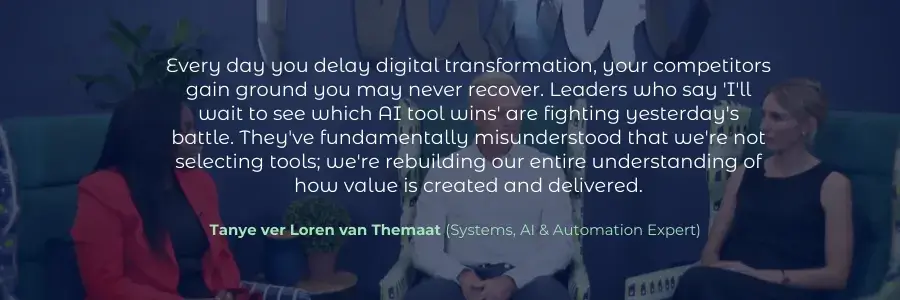
This stark warning from AI expert Tanye ver Loren van Themaat captures the existential challenge facing scaling businesses today. The brutal truth is: most businesses aren’t truly thinking about digital transformation and AI adoption strategically – they’re simply procrastinating while their competitive advantage quietly erodes.
Leaders who delay aren’t just risking business obsolescence; they’re actively endangering their employees’ future employability.
In the latest episode of The Cutting Edge Podcast, Edge Growth’s Susan Molosaine (CEO of Edge Growth Solutions) brings together Jason Krause, CEO of The Art of Scale, and Tanye ver Loren van Themaat (AI expert and Director of Thundamental) to cut through the hype and deliver actionable insights on AI adoption and digital transformation for scaling businesses.
Here are 5 principles to adopting AI that will separate businesses that will thrive in the AI economy from those headed for disaster. ⬇️
1. The Need To Rethink Business Models, Not Just Processes
Digital transformation isn’t about implementing technology on the fringes of your business – it’s about fundamentally reimagining how your organisation creates value.
When scaling, the search is no longer just for product-market fit, but for business model-market fit. Digital technologies and AI are driving rapid change in business model design itself.
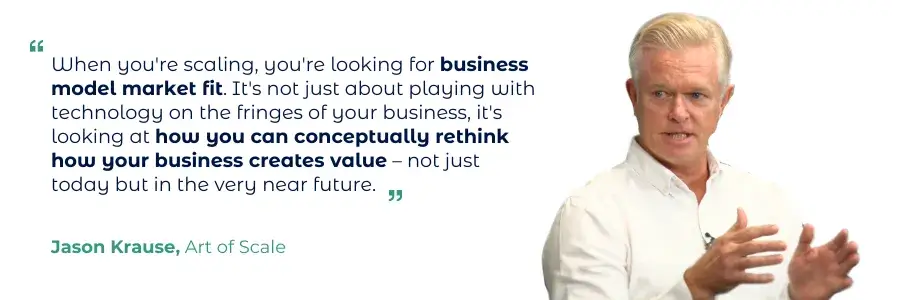
This means asking deeper questions like:
↳ How might my value proposition change with these technologies ❔
↳ Which customer segments become available❔
↳ What new revenue streams emerge❔
↳ How might my cost structure transform❔
The risk of inaction compounds quickly. Once competitors go up the experience curve with leveraging digital technologies, catching up becomes exponentially more difficult.
2. Start Small and Build Momentum, Rather Than Waiting for Perfection
The most common pattern holding businesses back is hesitation by those in charge (ie. Leadership).
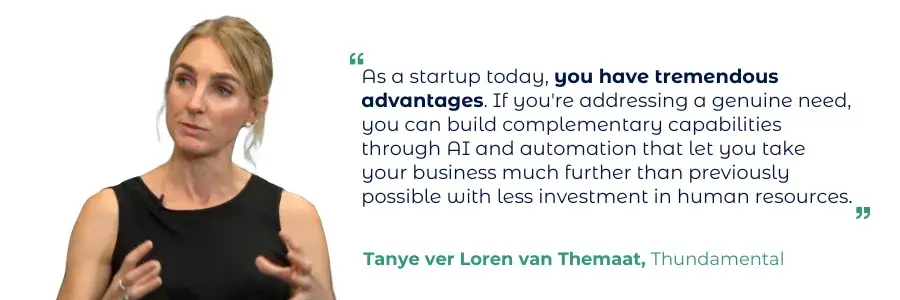
This approach is counterproductive. The landscape is evolving too rapidly for lengthy strategy development. The solution involves:
→ Jumping in and beginning to train employees
→ Identify team members already keen on AI, automation and digital tools
→ Empower these champions to build small solutions that pull the rest of the organisation forward
→ Focus on solving specific business problems through a technology lens
A particularly revealing insight Tanya highlights is that shadow AI is already happening in your organisation. Many employees are secretly using AI tools because they fear being penalised for efficiency or because no one is talking about it openly.
Creating safe spaces for experimentation and knowledge-sharing can transform this hidden activity into a powerful advantage.
💭 Reflect: When was the last time you openly discussed AI usage with your team? What small digital experiment could you start tomorrow?
3. Upskill for Relevance, Not Just Efficiency
Perhaps the most compelling argument for embracing digital transformation isn’t about technology at all – it’s about people.
“If leaders aren’t upskilling their employees or implementing a digital transformation strategy, their best team members will leave for more progressive companies. Those left behind have their futures compromised because they’re not learning the skills to stay relevant,” warns Tanya.
While approximately 80% of current work processes will change, the remaining 20% focused on human elements will become increasingly valuable. This creates an opportunity to rethink roles and responsibilities:
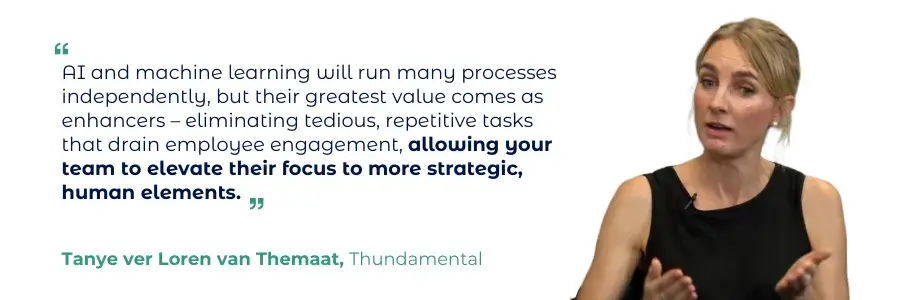
Employees need to develop new thinking processes:
⚪ Understanding the job to be done within a business system
⚪ Learning about emerging technology capabilities
⚪ Connecting those capabilities to use cases that fit within your context
Organisation leaders must create opportunities for employees to develop these skills through practical application and ongoing learning.
Jason added that employees need to develop new thinking processes:
1️⃣ Understand the job to be done within a business system
2️⃣ Learn about emerging technology capabilities
3️⃣ Connect those capabilities to use cases that fit within your context
💭 Consider: What repetitive tasks are draining your team’s time and energy that could be automated? What higher-value activities could they focus on instead?
4. Align Digital Transformation with Investment Strategy
For investors and businesses seeking funding, digital transformation capabilities are becoming key evaluation criteria. In Jasons words:
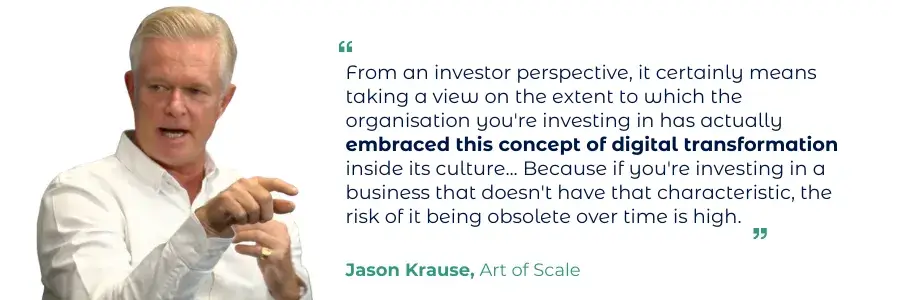
Investors increasingly recognise that the rapid pace of technological change means yesterday’s business model market fit may not persist. They’re looking for:
✔️ Evidence that digital transformation is embedded in company culture
✔️ Leadership that embraces innovation and experimentation
✔️ Future-fitness in business models based on digital technology trends
✔️ Clear understanding of whether a business is AI-native or AI-enabled
For entrepreneurs, this creates both challenges and opportunities:

The upside for early adopters extends beyond efficiency – it includes the ability to create entirely new value propositions that weren’t previously feasible.
5. Cultivate New Leadership Habits, Not Just Technologies
So where should a founder actually begin? The experts offered these practical starting points:
🟢 Leadership by example: “It’s the job of the leader to embrace digital transformation. You lead by example, and if there’s a leader in the business not embracing digital transformation, no one else in your organisation is going to.” – Jason
🟢 Cultivate curiosity: Create a culture aligned to innovation and digital technologies. Make digital transformation an ongoing conversation, not a one-off initiative.
🟢 Understand your workflows: “A lot of people do not understand their own workflows… If they don’t understand their workflows, we can’t use AI and automation tools to automate the process.” – Tanya
🟢 Start with the problem, not the technology: Identify bottlenecks in your business model first, then explore technology solutions.
🟢 Encourage experimentation: Create space for testing and learning with new tools, accepting that innovation will sometimes be messy.
For those concerned about potential risks, Tanya offers an important reminder:
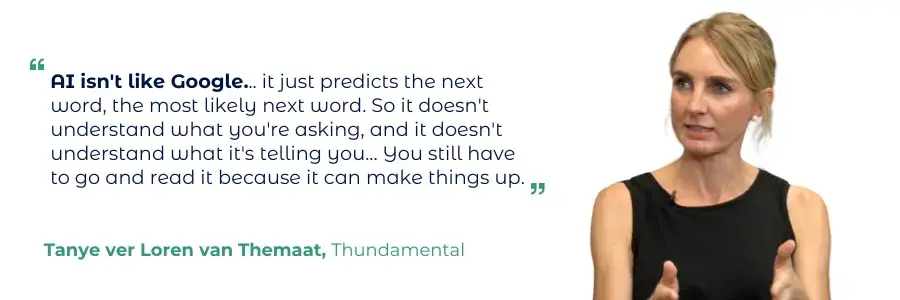
🟨 The Leaders Responsibility
Perhaps the most profound takeaway is the responsibility business leaders carry – not just to their organisations, but to their people:
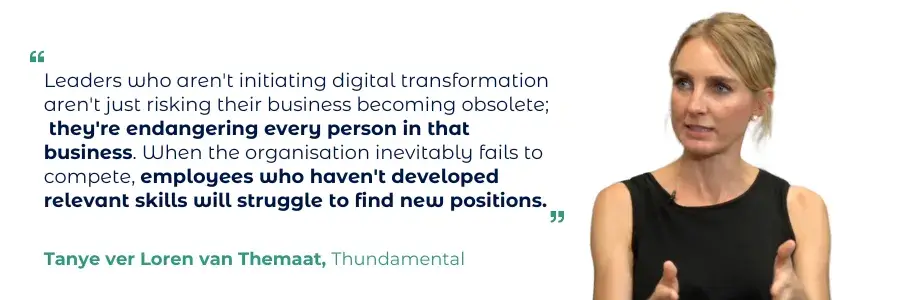
As we navigate accelerating technological change, it becomes clear that the greatest threat to jobs isn’t AI – it’s leadership inaction. When businesses fail because they refused to evolve, entire workforces pay the price of that negligence.
🟨 Moving Forward
Digital transformation is a journey, not a destination. It requires developing new mindsets, embracing continuous experimentation, and a willingness to reimagine how your business creates value.
As Susan concludes:

💭 Question: What’s your next step in your journey of digital transformation? What experiments will you run this quarter? How are you preparing your team for the AI-enabled future❓
Ready to dig deeper? The full episode of the Cutting Edge Podcast explores AI and Digital Transformation for SMEs in greater depth. Listen to it here.
Podcast Host: Susan Moloisane (CEO of Edge Growth Solutions)
Podcast Guests: Tanye ver Loren van Themaat (Director and Business Architect at Thundamental) and Jason Krause (CEO of The Art of Scale)



